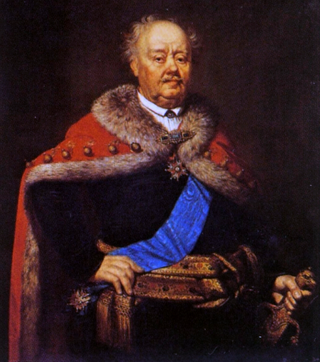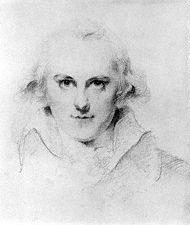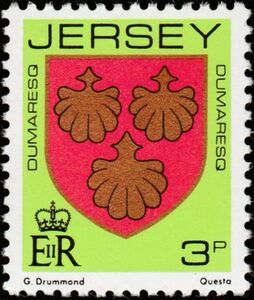Daniel Dumaresq | |
|---|---|
 Dumaresq in 1747 | |
| Born | 1712 |
| Died | 28 October 1805 (aged 94) |
| Parent | Elias Dumaresq |
Daniel Dumaresq FRS (1712 – 28 October 1805) was an educational consultant to Russian and Polish monarchs. [1] [2]
Daniel Dumaresq | |
|---|---|
 Dumaresq in 1747 | |
| Born | 1712 |
| Died | 28 October 1805 (aged 94) |
| Parent | Elias Dumaresq |
Daniel Dumaresq FRS (1712 – 28 October 1805) was an educational consultant to Russian and Polish monarchs. [1] [2]
Duraresq came from Trinity, Jersey, in the Channel Islands. His father was Jurat Elie Dumaresq, Seigneur of Augrès and was the fifth of eleven children. He attended John Roysse's Free School in Abingdon (now Abingdon School) from 1724 until 1730 and in 1730 entered Pembroke College where he studied for six years. In 1740, he was elected to a Jersey Fellowship at Exeter College, Oxford. [1] [2]
He became curate at Merton on Otmoor, Oxfordshire, (1744) then chaplain at the English Factory at St Petersburg (1746–62). During that time he was elected to the St Petersburg Academy of Sciences, became fluent in Russian and was chaplain to Sir Charles Hanbury (1708–59), British Ambassador to St Petersburg. He translated a book: An Account of that part of America which is nearest to Kamchatka, extracted from the Description by Professor Krasheninncoff, printed at Petersburg in 1759, and translated by the Rev. D. Dumaresq. In his capacity as chaplain to the ambassador he employed a secretary, Stanislaus Poniatowski, who later became king of Poland. [3]
Upon his return to England he took the rectory of Yeovilton (1762-1805) with neighbouring Limington (1790-1802). From there he was called upon to return to Russia and Poland to advise Catherine the Great (1762–96) of Russia and Stanislaus II (1764–95) King of Poland on educational matters. He was a Fellow of the Royal Society.
In 1800, he donated his library of books to his native island, a founding benefaction of the Jersey Library. He died on 28 October 1805 aged 94 at Bath, Somerset. [1] [2]
Joseph Bosworth was an English scholar of the Anglo-Saxon language and compiler of the first major Anglo-Saxon dictionary.

Stanisław II August, known also by his regnal Latin name Stanislaus II Augustus, and as Stanisław August Poniatowski, was King of Poland and Grand Duke of Lithuania from 1764 to 1795, and the last monarch of the Polish–Lithuanian Commonwealth.

Franciszek Ksawery Branicki (1730–1819) was a Polish nobleman, magnate, French count, diplomat, politician, military commander, and one of the leaders of the Targowica Confederation. Many consider him to have been a traitor who participated with the Russians in the dismemberment of his nation.

Alexander AubertFRS FSA, (1730–1805), was an English amateur astronomer and businessman.

Vice-Admiral Samuel Greig, also known as Samuil Karlovich Greig, was a Scottish-born Russian admiral who distinguished himself in the Battle of Chesma (1770) and the Battle of Hogland (1788). His son Alexey Greig also made a spectacular career in the Imperial Russian Navy.

Richard Pulteney FRS FRSE FLS was an English physician and botanist. He was a promoter of Linnaean taxonomy, and authored the first English language biography of Carl Linnaeus, entitled A General View of the Writings of Linnaeus.
Thomas Hayter was an English whig divine, who served as a Church of England bishop for 13 years as Bishop of Norwich (1749–1761) then Bishop of London (1761–1762), and was a royal chaplain. As a party advocate of the Pelhamites and a friend of the Duke of Newcastle, he was at the height of his powers in the 1750s. A scholar renowned in his days, it was for his divinity that Hayter was recommended, but his friendship with the court and royalty that exemplified his actual powers. He was considered tolerant and eclectic, learned and intelligent.

Samuel Lysons was an English antiquarian and engraver who, together with his elder brother Daniel Lysons (1762–1834), published several works on antiquarian topics. He was one of the first archaeologists to investigate Roman sites in Britain, and specialised in the study of mosaics.

Baron Thomas Dimsdale was an English medical doctor, banker and politician who sat in the House of Commons from 1780 to 1790. He was created Baron Dimsdale of the Russian Empire by Catherine the Great after inoculating her against smallpox. His cousin, housekeeper and third wife Elizabeth Dimsdale was a diarist and recipe collector.
Paweł Giżycki was a Polish Jesuit architect who worked in eastern regions of the Polish–Lithuanian Commonwealth.
John Chevallier, FRS was an eighteenth century academic, most notably Master of St John's College, Cambridge from 1775 until his death and Vice Chancellor of the University of Cambridge from 1776 until 1777.
Henry Farquharson was a teacher who pioneered the study of mathematics in Russia. He was recruited by Peter the Great, who sought to introduce Western ideas and technology into Russia. He moved to Moscow where he established a school and later established a naval academy in Saint Petersburg. Farquharson had a profound effect on the intellectual life of Russia, not only by introducing mathematical ideas but by helping to create the first generation of explorers, surveyors, cartographers and astronomers.
John Rogerson was a Scottish physician at the court of Catherine the Great of Russia.

Elias Dumaresq, 5th Seigneur of Augres was born in 1674 and was a Seigneur of Augres located in the parish of Trinity, Jersey, the largest of the Channel Islands, He belonged to the influential Dumaresq family.

The Dumaresq family was a patrician family in the Channel Islands with a particularly strong presence in Jersey. The family would hold many offices and positions throughout the history of Jersey from the 13th century.

Elias Dumaresq, 3rd Seigneur of Augrès was born to Abraham Dumaresq, 2nd Seigneur of Augrès and Susan de Carteret daughter of Philippe de Carteret I, 2nd Seigneur of Sark and his wife Racheal Paulet. He was a Royalist and a Jurat of the Royal Court.
{{cite web}}: CS1 maint: unfit URL (link)